Saskatchewan << sas KACH uh `wahn` >>, one of the Prairie Provinces of Canada, traditionally has been the greatest wheat-growing region in North America. Its farmers produce about two-fifths of Canada’s wheat. The province’s vast wheat fields gave it the nickname Canada’s Breadbasket. Railroads carry huge loads of grain to Canadian ports for shipment to all parts of the world.
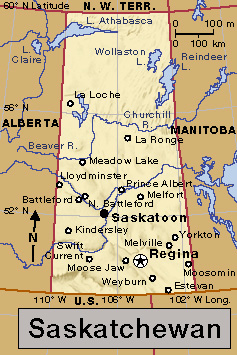
Saskatchewan has about two-fifths of the farmland in Canada—more than any other province. Saskatchewan’s farms are on its flat southern prairies and gently rolling parklands (grasslands with scattered groves of trees) where most of the people live. Tall grain elevators rise in the hundreds of towns and villages that dot the fertile plains. Saskatchewan ranks among the leading provinces in the production of barley, canola, flaxseed, oats, rye, and pulse crops (crops yielding pods of edible seeds, such as peas and beans). The farmers of Saskatchewan also raise large numbers of beef cattle.
Southern Saskatchewan is much more than a rich farming region. Major oil fields that were discovered during the 1950’s lessened the province’s dependence on agriculture. Today, Saskatchewan produces about 10 percent of Canada’s petroleum and is a leading oil producer of North America. Potash, a potassium salt used in fertilizers, was first mined in Saskatchewan in the early 1960’s. In less than 10 years, the province became a world leader in potash production. Large-scale potash mining is still a major industry.

Northern Saskatchewan is known for the scenic beauty of its boreal (northern) forest and its Canadian Shield region, which includes the province’s largest lakes. Northern Saskatchewan also has deposits of uranium. The province leads the world in uranium production. The region’s commercially valuable trees include birch, Eastern larch, fir, jack pine, poplar, and spruce. Caribou, elk, and moose roam the rugged forests. Northern pike, pickerel, trout, and whitefish swim in the sparkling lakes and streams. The people of northern Saskatchewan live in small, scattered communities throughout the region. They earn their living through commercial fishing, prospecting and mining, trapping, and working in the lumber and tourist industries.
The province took its name from the Saskatchewan River, named by the Indigenous (native) Cree people. They called the winding river Kisiskadjewan or Kis-is-ska-tche-wan, meaning fast flowing or river that turns around when it runs.
For Saskatchewan’s relationship to the other provinces of Canada, see Canada; Canada, Government of; Canada, History of; Prairie Provinces.
People
Population.
The 2021 Canadian census reported that Saskatchewan had 1,132,505 people. The province’s population had increased by about 3 percent since the 2016 census, which reported a figure of 1,098,352.
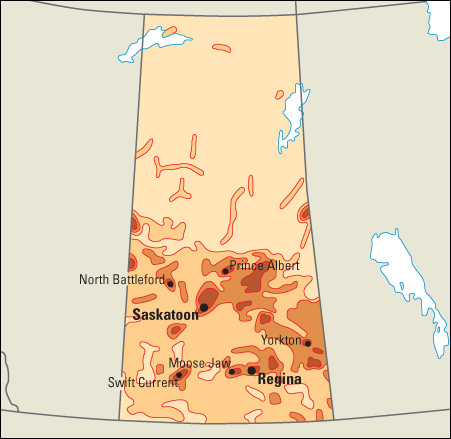
Most of Saskatchewan’s people live in the southern part of the province. About two-thirds of the people live in cities and towns. Saskatchewan has two Census Metropolitan Areas as defined by Statistics Canada: Regina and Saskatoon. About half of the province’s people live in these two metropolitan areas (see Metropolitan area). Saskatchewan’s largest cities, in order of population, are Saskatoon, Regina, Prince Albert, and Moose Jaw. For more information, see the separate articles on the cities and towns of Saskatchewan listed in the Related articles feature that accompanies this article.
About 85 percent of Saskatchewan’s people were born in Canada. Most of those born in other countries came from the United States, the United Kingdom and other parts of Europe, and Asia. Many of the province’s people have some British ancestry. Other large groups include French, Germans, and Ukrainians.
There are approximately 102,000 First Nations people in Saskatchewan. First Nations make up one of three main Indigenous groups in Canada, along with the Inuit and Métis. About half of the province’s First Nations people live on reserves. The remaining First Nations people and several thousand Métis << may TEES or may TEE >>, people of mixed European and First Nations ancestry, live mainly in the province’s northern and central regions (see Métis).
Schools.
In 1840, the Church of England and the Hudson’s Bay Company established the first school in the Saskatchewan region, at the settlement of Cumberland House. Missions and churches provided the only schooling in the region until 1884. That year, the federal government started a system of public education.
Today, the province’s public school divisions are governed by local boards of education. They receive public funding. Saskatchewan also has a number of schools that are not part of the public system, including some Christian, Francophone (French-language), and First Nations schools. Children between 7 and 16 years old must attend school.
Libraries.
The first public library in Saskatchewan was established in Regina in 1908. Other libraries include the Legislative Library in Regina and the University of Saskatchewan and University of Regina libraries.
Museums.
The Royal Saskatchewan Museum in Regina features galleries that trace the natural history of Saskatchewan and the history of its First Nations. The Royal Canadian Mounted Police Heritage Centre and the MacKenzie Art Gallery are also in Regina. The Remai Modern art museum is in Saskatoon. The Western Development Museum, with branches in various cities, has exhibits on the province’s social and economic history. The Ukrainian Museum of Canada in Saskatoon displays clothing and crafts of Ukrainian immigrants. Wanuskewin Heritage Park, outside Saskatoon, showcases Indigenous cultures of the northern Great Plains.
Visitor’s guide
Saskatchewan’s landscape includes beaches, forested highlands, lakes, river valleys, and vast woodlands. These areas provide opportunities for bird watching, camping, canoeing, hiking, horseback riding, and other activities.
Northern Saskatchewan offers some of the best hunting and fishing in North America. Sports enthusiasts go there to hunt bear and moose or to fish for grayling, northern pike, lake trout, and walleye.
In southern Saskatchewan, the sparkling lakes of the Qu’Appelle Valley have popular summer resorts that feature boating, fishing, golfing, and swimming. Various historic parks and monuments honor battlefields and forts from Saskatchewan’s colorful past. Many markers identify early trails used by hunters, fur traders, and patrols of the old North-West Mounted Police. Communities around Saskatchewan hold rodeos and a variety of festivals. Festive First Nations gatherings called powwows also take place.

Land and climate
Land regions.
Saskatchewan has four land regions: (1) the Canadian Shield, (2) the Manitoba Lowland, (3) the Saskatchewan Plain, and (4) the Alberta Plain. The lowland and the plain regions form part of the Western Interior Plains, the Canadian section of the North American Great Plains.
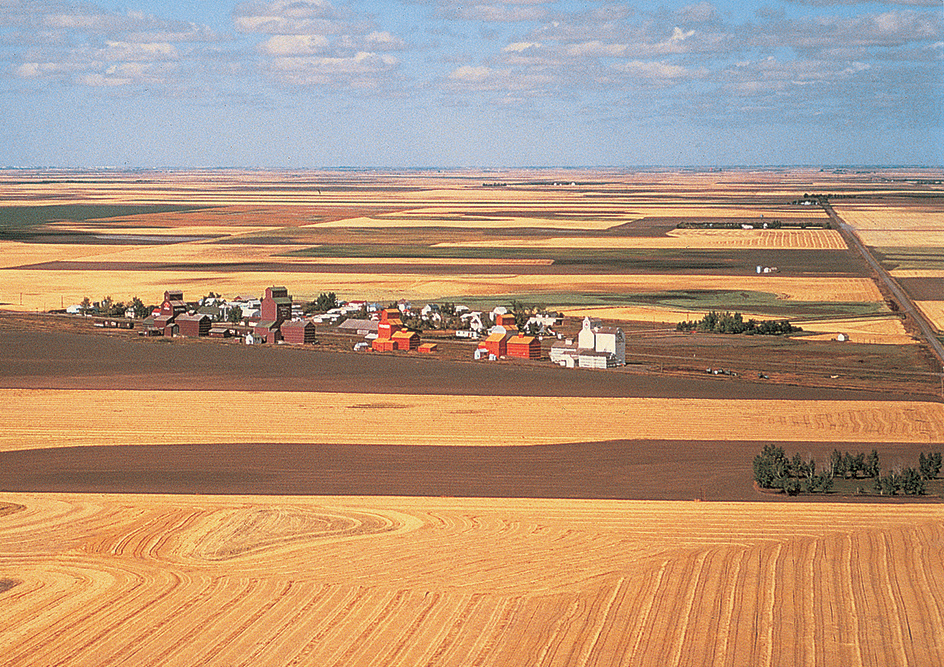


The Canadian Shield
is a vast, horseshoe-shaped region that covers almost half of Canada and dips into the United States. This rough area, made up of ancient granites and other rocks, covers most of the northern half of Saskatchewan. It has deposits of copper, uranium, zinc, and many other minerals. The region also has the largest lakes in the province. Pine and spruce forests cover most of the land. See Canadian Shield.
The Manitoba Lowland
extends westward from the Manitoba border for about 90 miles (140 kilometers). Rocky soils and poor drainage make the land generally unsuitable for farming. The region has large areas of marshes and forests, and many lakes and rivers.
The Saskatchewan Plain
is mostly level land, broken by some low hills. Most of the region is from 1,700 to 2,000 feet (518 to 610 meters) above sea level. Commercial forests grow in the northern part of the plain. To the south are grasslands, called parklands, with scattered groves of trees that give way to almost treeless plains. Saskatchewan’s chief farming area lies in this region.
The Alberta Plain
is separated from the Saskatchewan Plain by a hilly belt called the Missouri Coteau or Missouri Escarpment. Most of the region is rolling, treeless land, 2,000 to 3,000 feet (610 to 910 meters) high, with deep river valleys. The highest point in the province rises to 4,567 feet (1,392 meters) in the Cypress Hills, a wooded plateau in the southwest. The region’s northern strip extends into the commercial forest belt.
Rivers and lakes.
Southern Saskatchewan has few major rivers and lakes. The most important river is the Saskatchewan River, 1,205 miles (1,939 kilometers) long. It is fed by waters from the Rocky Mountains in Alberta. Its major branches in the province are the North Saskatchewan and South Saskatchewan rivers. The Assiniboine River and its main branches, the Qu’Appelle and Souris, drain southeastern Saskatchewan. The largest lakes in the south are Old Wives and Quill lakes, which are shallow and salty, and Last Mountain Lake.
Gardiner Dam, built on the South Saskatchewan River near Outlook, created a 170-square-mile (440-square-kilometer) reservoir called Lake Diefenbaker. It provides water to irrigate 500,000 acres (200,000 hectares) of farmland as well as hydroelectric power.
Northern Saskatchewan has a majority of the province’s rivers and lakes. The Churchill River system and the rivers flowing into Lake Athabasca drain northern Saskatchewan. Many northern rivers are actually narrow lakes that connect with each other. Lake Athabasca, the largest of Saskatchewan’s many lakes, covers 3,064 square miles (7,935 square kilometers). About a third of this lake extends into Alberta. Other large lakes include Reindeer, Wollaston, La Ronge, and Cree lakes.
Plant and animal life.
Forests cover about 91,000 square miles (235,000 square kilometers) in Saskatchewan—about a third of the province’s total area, including inland water. About 40,000 square miles (104,000 square kilometers) are available for logging. These forests extend across the province in an irregular belt about 150 miles (241 kilometers) wide, most of it north of Prince Albert. The most valuable trees in this belt are birch, jack pine, poplar, and spruce. Other trees include balsam fir and larch.
The provincial flower, called the wood lily or western red lily, grows throughout the plains regions, as do cactuses, crocuses, vetches, and violets. Such shrubs as blueberries, chokecherries, hazels, and wild roses grow in the woodlands.
Elk, moose, and barren-ground caribou live mainly in woodlands of the central and northern regions. Deer and rabbits may be seen throughout the province. Fur-bearing animals in the forests include bears, beavers, minks, otters, and wolves. Pronghorns and coyotes roam the southwestern plains. Game birds, especially ducks and geese, nest along the lakes. Partridges, pheasants, and ruffed and sharp-tailed grouse live in the southern Saskatchewan Plain. The lakes and rivers have northern pike, perch, trout, tullibee, walleye, and whitefish. Grayling live chiefly in the northern waters.
Climate.
Saskatchewan has short, warm summers and cold winters. Average January temperatures range from –17 °F (–27 °C) in the north to 9 °F (–13 °C) in the south. Warm chinook winds may raise winter temperatures in the south as much as 20 degrees Fahrenheit (11 degrees Celsius) within a few hours (see Chinook). Average July temperatures vary between 61 °F (16 °C) in the north and 67 °F (19 °C) in the south. 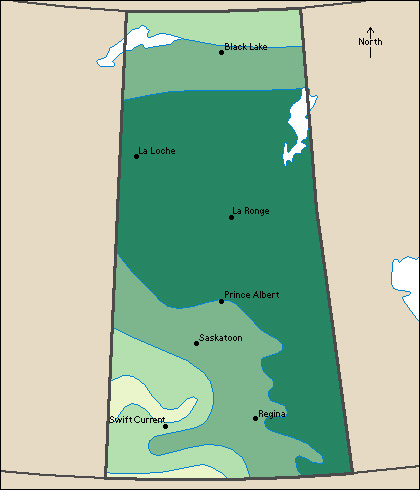
Saskatchewan’s annual precipitation ranges from 14 to 19 inches (35 to 49 centimeters) in most places. Annual snowfall in the province varies from 41 inches (105 centimeters) in the south to 98 inches (250 centimeters) in the north.
Economy
Before the 1870’s, the economy of the Saskatchewan region was based on the fur trade and hunting. European traders began to interact with the area’s First Nations people in the late 1600’s. Grain farming and ranching became important in the province during the late 1800’s. Mining became significant after large deposits of petroleum, potash, and uranium were discovered in the 1950’s.
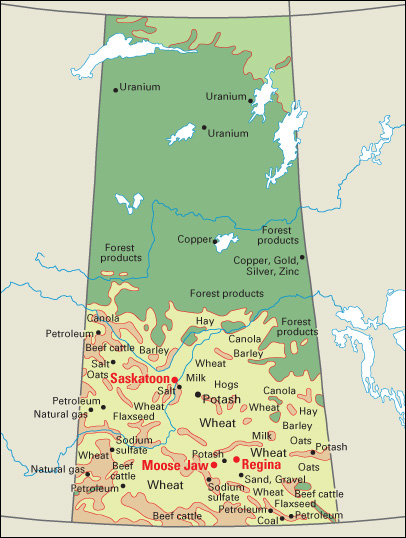
Today, service industries account for the largest part of Saskatchewan’s gross domestic product (GDP)—the total value of goods and services produced in the province annually. Nonrenewable resources, including mined products, play a major role in Saskatchewan’s economy. Agriculture also is important, but to a lesser degree. The province is an important producer of petroleum, potash, and uranium.
Natural resources
of Saskatchewan include fertile soils and valuable minerals.
Soil.
The rich grassland soils of southern Saskatchewan are probably the province’s chief natural resource. These soils lie in parallel zones that slant from northwest to southeast. The far southwestern zone has brown soils that produce good crops when enough rain falls. But the region is dry, and much of the land is used for raising cattle. Rainfall increases to the northeast, where dark brown and black soils are found. These soils in the south-central part of Saskatchewan are the most fertile in the province. The northern forest region has gray, less fertile soils.
Minerals.
The Canadian Shield of northern Saskatchewan has varied mineral deposits. Uranium deposits are the most important. Other mineral deposits in northern Saskatchewan include gold, sand and gravel, and silver. Kimberlite, a kind of rock that contains diamonds, also has been found.
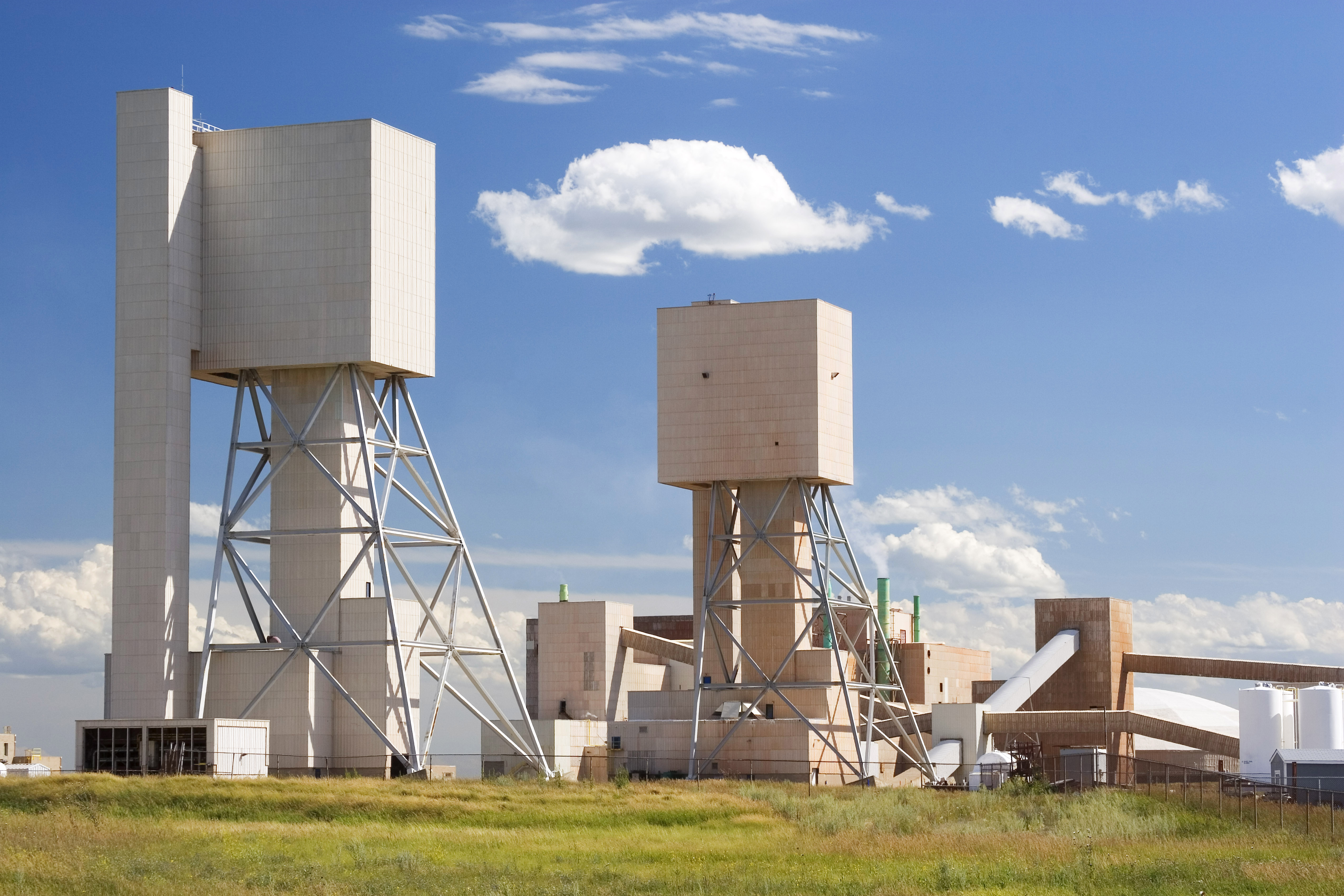
In the south and south-central regions, the most important mined products are potash, petroleum, coal, and sodium sulfate. The southern part of Saskatchewan also has deposits of natural gas and salt.
Service industries
account for about half of Saskatchewan’s gross domestic product and employ about three-fourths of its people. Saskatchewan’s service industries are concentrated in the province’s major cities.
Provincial government activities are based in Regina, and Regina is also the province’s chief financial center. Many trucking firms operate in Regina and Saskatoon. A large military air base in Moose Jaw provides many jobs. The University of Regina and the University of Saskatchewan in Saskatoon also employ many people.
Freight trains are a vital part of the transportation industry because they carry cattle, minerals, wheat, and other commodities to markets. Pipelines, which carry oil and gas, are also an important method of transportation.
Mining.
Petroleum is Saskatchewan’s most important mined product. The province has four major petroleum-producing regions: Estevan-Weyburn in the southeast; Swift Current and Kindersley, both in the southwest; and Lloydminster in the west-central part of Saskatchewan. More than half of the petroleum produced in Saskatchewan is exported to the United States. Much of the remainder of Saskatchewan’s production is sold in Canada’s eastern provinces.
Saskatchewan’s other leading mined products include natural gas, potash, and uranium. Natural gas is produced primarily in the southwestern part of the province. Saskatchewan is the largest potash producer in the world. Saskatchewan’s potash mines are in the southern third of the province. The province is one of the world’s leading uranium-producing regions. The Wollaston Lake area in northeast Saskatchewan and the Key Lake area in north-central Saskatchewan produce most of the province’s uranium.
Agriculture.
Saskatchewan has more farmland than any other province. Saskatchewan’s farms cover most of the land west and south of the Manitoba Lowland. Each year, some of the cropland is left fallow (not planted) to accumulate moisture and control weeds.
Saskatchewan grows more crops than any other province. Canola, which is used to make canola oil, and wheat are Saskatchewan’s chief crop products. Saskatchewan is Canada’s leading producer of both canola and wheat. The province accounts for about two-fifths of Canada’s total wheat production and about half of the total canola production. Production of canola and wheat is especially heavy in south-central Saskatchewan. The province also ranks among Canada’s leading producers of barley, flaxseed, lentils, mustard seeds, oats, peas, and rye.
The raising of beef cattle also contributes significantly to Saskatchewan’s economy. The largest cattle-raising areas are near Lloydminster, Moosomin, Swift Current, and Yorkton. But almost all parts of southern Saskatchewan have some cattle. Saskatchewan farmers also raise large numbers of dairy cattle and hogs, especially in the area just east of Saskatoon.
Manufacturing
accounts for a small share of the gross domestic product in Saskatchewan compared with most of the other provinces. Manufacturing is concentrated in the cities, especially Regina and Saskatoon. Much of Saskatchewan’s manufacturing is dedicated to processing its agricultural, forest, and mined products.
Many agricultural commodities are processed to make food and beverages. Most food processing occurs in the Regina and Saskatoon areas. Meat packing is an important industry. Other important products include baked goods, processed grain and oilseed, dairy products, fruit products, and specialty foods, such as wild rice from northern Saskatchewan.
Saskatchewan’s forests are used for manufacturing paper and wood products. Much of the wood products are used for building houses in Canada and the United States. Oil refineries are in Lloydminster and Regina. Potash, a potassium salt, is manufactured into fertilizers. Farm machinery is also manufactured in the province.
Electric power and utilities.
Hydroelectric plants, plants that burn coal, and plants that burn natural gas provide almost all of Saskatchewan’s electric power. Wind turbines also generate small amounts of electric power. The Saskatchewan Power Corporation, a government-owned company, controls most of the province’s power plants.
Transportation.
An extensive network of paved two-lane highways links most of the major cities of southern Saskatchewan. Four-lane highways connect Regina to Saskatoon and Swift Current. The Trans-Canada Highway passes through southern Saskatchewan, including Regina, Moose Jaw, and Swift Current. The Yellowhead Highway, a northern branch of the Trans-Canada Highway system, passes through Yorkton, Saskatoon, and North Battleford. Most of the highways in northern Saskatchewan are unpaved.
The province’s busiest airports are in Regina and Saskatoon. Several small airlines provide transportation to remote areas in the northern part of the province. Saskatchewan’s major railway centers include Moose Jaw, Regina, Saskatoon, and Weyburn.
Communication.
The first newspaper in the Saskatchewan region was the Saskatchewan Herald, established in Battleford in 1878. Today, Saskatchewan’s leading daily newspapers include the Leader-Post of Regina, the Prince Albert Daily Herald, and The StarPhoenix of Saskatoon.
Government
Lieutenant governor
of Saskatchewan represents the British monarch, Canada’s official head of state, in the province. The lieutenant governor is appointed by the governor general in council—that is, the governor general of Canada acting with the advice and consent of the federal Cabinet. The position of lieutenant governor is largely honorary.
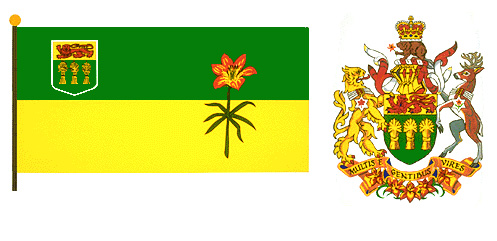
Premier
of Saskatchewan is the actual head of the provincial government. Saskatchewan, like Canada itself, has a parliamentary form of government. The premier is an elected member of the Legislative Assembly. The person who serves as premier must have support from a majority of the members of the legislature and is usually the leader of the party with the most seats in the Legislative Assembly.
The premier presides over the Executive Council. The Executive Council also includes other ministers who are chosen by the premier. These ministers usually are chosen from members of the premier’s party in the Legislative Assembly. However, there can also be a coalition government with ministers from more than one party. Each of the ministers on the Executive Council directs one or more departments of the provincial government. The premier and the Executive Council resign if they lose the support of a majority of the members of the Legislative Assembly.
Legislative Assembly
of Saskatchewan is a one-house legislature that makes provincial laws. One member is elected to the Assembly from each of the province’s constituencies (electoral districts). 
Elections for the province’s Legislative Assembly are held every four years, with some exceptions. However, the government may call an election before four years have passed. When this happens, the lieutenant governor, on the advice of the premier, dissolves the Legislative Assembly.
Courts.
Saskatchewan’s highest court is the Court of Appeal. It consists of the chief justice of Saskatchewan and seven puisne (associate) judges. Another court, the Court of King’s Bench, holds sessions in various parts of Saskatchewan. All members of the Court of Appeal and Court of King’s Bench are appointed by the governor general in council. The retirement age for the chief justices and judges is 75. Some judges can choose to serve part-time as supernumerary judges until they turn 75. The Executive Council appoints judges to the Provincial Court.
Local government.
Incorporated communities in the southern, more populated half of Saskatchewan are divided into urban and rural municipalities. Urban municipalities are classified by the size of their population and include cities, towns, villages, and resort villages.
Most urban and rural municipalities are governed by councils. Members of these councils are elected to serve terms of up to four years. A mayor or an official called a reeve heads each council.
Saskatchewan’s Northern Administration District covers the thinly populated northern half of the province. The incorporated communities in northern Saskatchewan are called northern municipalities. They are classified, according to their population size, as northern towns, northern villages, or northern hamlets. Each of the communities has a local governing group. First Nations reserves throughout Saskatchewan have their own forms of government.
Revenue.
Taxes levied by the provincial government account for about half of Saskatchewan’s general revenue (income). The most important taxes are a general sales tax and a personal income tax. The province also collects taxes from corporations and from purchasers of alcohol, gasoline, and tobacco products.
Other revenue sources include motor vehicle fees, the leasing of Crown (government-owned) lands, and royalties on the exploration and extraction of natural resources. The provincial government receives additional revenue from national and provincial tax-sharing arrangements.
Politics.
The major political parties of Saskatchewan are the New Democratic Party and the Saskatchewan Party. The party that is now called the New Democratic Party was formed in 1961 by a merger of several labor unions with the Co-operative Commonwealth Federation (CCF). The CCF was a socialist party. The Saskatchewan Party was established in August 1997 by a number of Liberals and Progressive Conservatives.
History
Early days.
The first people to occupy the area that became Saskatchewan were First Nations people who probably arrived in the region about 12,000 years ago. Through the centuries, the First Nations of the area developed a rich culture. Their daily lives were filled with spiritual meaning. They were skilled traders who exchanged goods and ideas with other groups. Perhaps most importantly, they were resourceful people who understood the natural world and readily adapted to changing conditions.
When Europeans arrived in Saskatchewan in the late 1600’s and early 1700’s, the Indigenous Chipewyan (also called Denesuline) people lived in small bands in the northern woodlands. Their main food was caribou. In spring and fall, the bands joined in larger groups to hunt caribou as the animals migrated in large herds. The Chipewyan also hunted moose and smaller game, and they fished.
The Cree were the most widespread group in central Saskatchewan. They took advantage of the resources of both forest and prairie. They lived on fish, waterfowl, and plants in the summer and turned to elk and deer during the winter. Those Cree living farthest to the north also hunted caribou, and those to the south hunted buffalo. In the south, the Assiniboine, Gros Ventre, and some Plains Cree hunted the large buffalo herds that roamed the plains. See Cree.
The coming of the fur traders.
The adaptability of the First Nations enabled them to take advantage of the European fur trade when it arrived in western Canada. The Cree and Assiniboine, especially, profited by buying furs from other First Nations people who trapped them and selling the pelts to English and French traders.
In 1670, King Charles II of England granted control of a vast region of western Canada, including most of Saskatchewan, to the Hudson’s Bay Company, an English fur-trading organization. The first European known to visit Saskatchewan was a Hudson’s Bay Company employee named Henry Kelsey. From 1690 to 1692, Kelsey traveled in the west, trying to contact new Indigenous groups and persuade them to trade with the company. 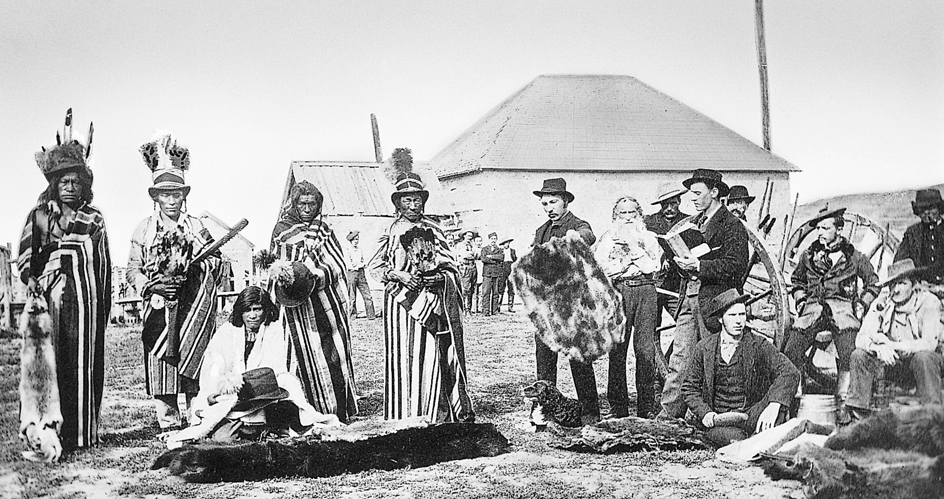
In the mid-1700’s, rival French fur traders expanded their operations into central Saskatchewan. In 1779, merchants and fur traders based in Montreal formed the North West Company to compete with the Hudson’s Bay Company. The North West Company extended its operations across Saskatchewan during the late 1700’s.
Growing competition led the North West and Hudson’s Bay companies to build numerous trading posts and forts in Saskatchewan. In 1774, Samuel Hearne of the Hudson’s Bay Company established a trading post at Cumberland Lake in Saskatchewan, the company’s first inland post in Canada. The trading post, called Cumberland House, was the first continuously occupied settlement in Saskatchewan.
The two fur-trading companies decided to trade directly with the First Nations people who trapped the furs, no longer relying on the Cree and Assiniboine to buy pelts from the trappers. Those two tribes turned instead to supplying buffalo meat and other provisions for the fur traders. Using guns and horses acquired from the Europeans, some Cree moved onto the open plains to hunt buffalo.
In 1821, the two rival trading companies combined under the name Hudson’s Bay Company and ended their competition. In Saskatchewan, the merged company closed many trading posts.
The coming of the missionaries.
In the mid-1800’s, Saskatchewan became the scene of much missionary activity. A Roman Catholic mission was established at Île-à-la-Crosse in 1846, and Roman Catholic influence soon spread through northwestern Saskatchewan. Anglican missionaries built the Church of the Holy Trinity at Stanley Mission near the west end of Lac La Ronge. The church, completed about 1860, stands as the oldest existing structure in Saskatchewan.
North-West Territories.
The Dominion of Canada, a union of four provinces, was created in 1867. In 1869, the Hudson’s Bay Company agreed to sell the vast territory it controlled, including what are now northern Quebec, northern Ontario, and all the lands west to British Columbia, to the newly formed Dominion. The Dominion took control of the region in 1870. It created a small province of Manitoba and organized the remainder, including Saskatchewan, as the North-West Territories.
In the late 1850’s, the Irish explorer John Palliser, working for the British government, and the Canadian geologist Henry Y. Hind had led separate expeditions to central and southern Saskatchewan. Both reported that a broad belt of good land for farming ran through central Saskatchewan. As a result, the first European Canadian settlers in the 1870’s headed to the valleys of the North and South Saskatchewan River in central Saskatchewan. Battleford became the territorial capital in 1876.
In 1882 and 1883, the Canadian Pacific Railway built a transcontinental rail line across southern Saskatchewan, through Regina and Moose Jaw. In 1883, Regina officially became the new capital of the North-West Territories.
Métis and First Nations troubles.
About this time, the Métis of central Saskatchewan were concerned about securing their landholdings in the face of new settlers and the coming of the railway. They also wanted to take part in the new agricultural economy. Because the federal government failed to respond to their petitions, the Métis set up a temporary government at Batoche, Saskatchewan, in March 1885 to negotiate with the government in Ottawa. Fighting broke out, and the federal government sent a large military force to Batoche to disband the Métis. The government troops crushed the uprising, called the North West Rebellion, within three months (see North West Rebellion).
The First Nations of Saskatchewan also had troubles. The rapid decline of the once great buffalo herds left the First Nations without their chief source of food. The federal government urged them to become farmers instead of hunters, but it gave them little help to make the transition. Despite their troubles, few First Nations people became involved in the North West Rebellion. The Cree leaders Big Bear and Poundmaker tried to pursue peaceful dealings with Ottawa. Yet the Canadian government used the rebellion to justify harsh measures against the Cree. Many warriors were imprisoned for treason. Six Cree and two Assiniboine were executed at Battleford in November 1885 for their actions during the rebellion.
Territorial progress.
Settlement was rapid in the late 1890’s and early 1900’s. Agricultural development gained strength after farmers began to plant a type of wheat that thrived in Saskatchewan’s short growing season. New settlers established homesteads in record numbers. From 1901 to 1911, the population increased from 91,279 to 492,432. Good free land and rising wheat prices attracted many immigrants from Scandinavia and central and eastern Europe. Rapid population growth spurred the building of railroads, towns, and cities. In general, white settlers believed Saskatchewan’s Indigenous peoples would play only a minor role in the province’s future. 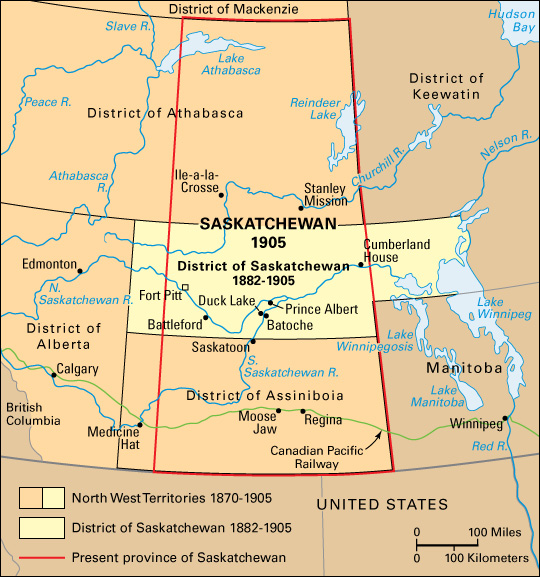
Saskatchewan became a province of Canada in 1905. However, the federal government kept control of Saskatchewan’s public lands and natural resources, including its forests and mineral deposits, until 1930.
Saskatchewan farmers greatly increased the amount of land devoted to growing wheat during World War I (1914-1918). In 1915 alone, Saskatchewan harvested over 200 million bushels of wheat. In 1924, a group of farmers formed the Saskatchewan Wheat Pool to get higher prices for their grain by selling directly to international markets. Today, the Wheat Pool is part of Viterra, one of the largest grain-marketing companies in the world.
In response to international demand, the amount of land planted in wheat climbed further in the 1920’s, topping 14 million acres (5.67 million hectares) in 1929. But the province’s economy depended on a single crop, and prosperity rose and fell with world wheat prices. Saskatchewan farmers believed the federal government often failed to protect their interests. In 1920, farmers from Saskatchewan and other provinces formed the Progressive Party, hoping for a greater voice in national affairs.
The Great Depression
of the 1930’s hit Saskatchewan hard. Wheat prices plunged to their lowest level in Saskatchewan’s history. A prolonged drought and soil erosion, aggravated by poor tilling practices, compounded the crisis. Tens of thousands of farm families went on relief or abandoned their homesteads. Many people moved to the edge of Saskatchewan’s northern forest, which had not suffered the extreme drought conditions, or left the province altogether. Single, homeless men wandered Canada by rail, searching for work.
In 1935, hundreds of unemployed men organized the On to Ottawa Trek, an expedition from British Columbia to the nation’s capital to appeal to the federal government for more help. The government ordered the demonstrators to halt at Regina. When police acting on federal orders tried to arrest the leaders in July 1935, a riot broke out. Many people were injured, and one police officer was killed.
Political changes
resulted from the Depression. In 1944, Saskatchewan voters elected the Co-operative Commonwealth Federation (CCF), which formed the first socialist government in North America. Under its leader, Thomas C. (Tommy) Douglas, the CCF swept to power determined to lessen the impact of poor harvests and dips in crop prices. The party backed the growth of manufacturing as well as the development of natural resources.
The CCF also pioneered in tax-supported health care. In 1962, the provincial government introduced a medical care plan for all citizens of the province. Saskatchewan doctors immediately withdrew their services, except in emergency cases. The doctors remained on strike for over three weeks until they reached a settlement with the province. The Saskatchewan program became the model for Canada’s national medical care plan, commonly called medicare, adopted in 1966.
In 1961, the CCF merged with several labor unions to form a national party called the New Democratic Party (NDP). The Saskatchewan branch kept the CCF name until 1967, when it also became the New Democratic Party. The NDP controlled the provincial government from 1944 to 1964, when it lost to the Liberal Party.
Economic changes.
During the middle and late 1900’s, large farms replaced many of Saskatchewan’s small family farms, and the number of farms decreased steadily. In the 1940’s, about three-fourths of Saskatchewan’s population lived in rural areas. By the early 1970’s, only half the population was rural.
Other resources offered promise. Huge potash beds and major deposits of petroleum had been discovered in the 1940’s and early 1950’s. In 1971, the NDP regained control of the provincial government. It established the Potash Corporation of Saskatchewan in 1975 and bought several large potash mines for it to run.
From 1982 to 1991, the Progressive Conservative Party controlled Saskatchewan’s government. The Progressive Conservatives rejected the NDP policy of government ownership. Instead, the Conservatives sought to generate wealth by aiding private enterprise. Neither party, however, managed to solve the basic problems of Saskatchewan’s economy, which remained largely dependent on fluctuating world prices for agricultural products and nonrenewable resources. The province’s population declined in the late 1980’s and early 1990’s as people left in search of better economic opportunities.
Saskatchewan’s troubled economy eventually benefited from the mining of rich uranium deposits in northern Saskatchewan and from large sales of potash. Another bright spot was a booming high technology industry in Saskatoon, especially in the field of agricultural biotechnology. In 1991, the NDP regained control of the provincial government. However, it lost control to the center-right Saskatchewan Party in 2007.
Many challenges face Saskatchewan in the 2000’s. The province must find a way to bring greater stability to an economy based on agricultural and mineral commodities. It also must meet the different needs of a growing urban population and an aging rural population. The province must foster cooperation between its Indigenous and non-Indigenous peoples and work to break down barriers between them.
